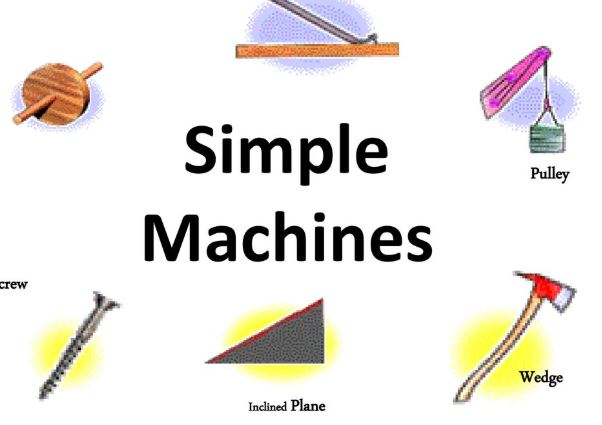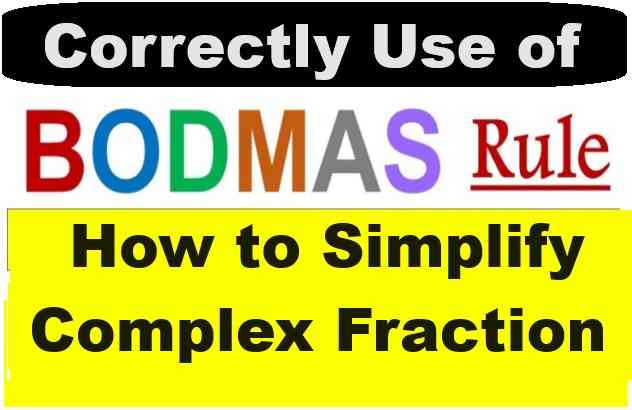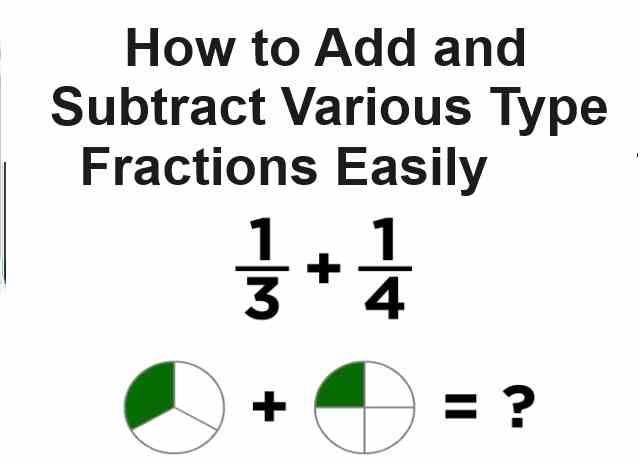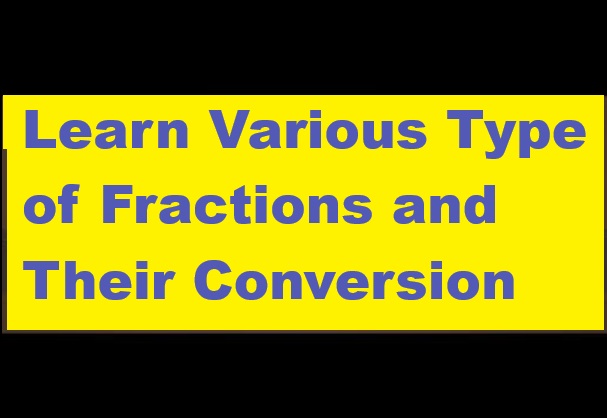Machines ICSE Class-10 Concise Selina Physics Solutions Chapter-3. We Provide Step by Step Answer of Exercise-3(A), MCQs-3(A), Numericals-3(A), Exercise-3(B), MCQ-3(B), and Numericals -3(B) Questions of Exercise-3 Machines ICSE Class-10 . Visit official Website CISCE for detail information about ICSE Board Class-10.
| Board | ICSE |
| Publications | Selina Publication |
| Subject | Physics |
| Class | 10th |
| Chapter-3 | Machines |
| Book Name | Concise |
| Topics | Solution of Exercise-3(A), MCQs-3(A), Numericals-3(A), Exercise-3(B), MCQ-3(B), and Numericals -3(B) |
| Academic Session | 2021-2022 |
Machines ICSE Class-10 Concise Selina Physics Solutions Chapter-3
-: Select Exercise :-
Exercise-3(A), MCQs-3(A), Numericals-3(A),
Exercise-3(B), MCQ-3(B), and Numericals -3(B)
Important Topics of Chapter-3 Machines for ICSE Class-10
Concept of machine including load, fulcrum and effort.Today is various type machine discuss in Solution of Selina Physics but complex machines are combination of simple machine. Although there are many term in machine yet velocity ratio and efficiency are most important term among machine . There are many simple machine in Chapter -3 of Selina Physics such that liver.pulley, inclined plane but in ICSE Physics 2021 only liver and pulley is in latest syllabus.
Excercise 3 (A) Machines (Selina Concise Physics Solutions)
Page 57
Question 1
(a) What do you understand by a simple machine?
(b) State the principle of an ideal machine.
Answer 1
(a) A machine is a device by which we can either overcome a large resistive force at some point by applying a small force at a convenient point and in a desired direction or by which we can obtain a gain in the speed.
(b) An ideal machine is a machine whose parts are weightless and frictionless so that which there is no dissipation of energy in any manner. Its efficiency is 100%, i.e. the work output is equal to work input.
Question 2
State four ways in which machines are useful to us?
Answer 2
Machines are useful to us in the following ways:
(1) In lifting a heavy load by applying a less effort.
(2) In changing the point of application of effort to a convenient point.
(3) In changing the direction of effort to a convenient direction.
(4) For obtaining a gain in speed.
Question 3 (Machines ICSE Class-10 Concise )
Name the machine for each of the following use:
(a) to multiply the force,
(b) to change the point of application of force,
(c) to change the direction of force,
(d) to obtain the gain in speed.
Answer 3
(a)To multiply force: a jack is used to lift a car.
(b)To change the point of application of force: the wheel of a cycle is rotated with the help of a chain by applying the force on the pedal.
(c)To change the direction of force: a single fixed pulley is used to lift a bucket full of water from the well by applying the effort in the downward direction instead of applying it upwards when the bucket is lifted up without the use of pulley.
(d)To obtain gain in speed: when a pair of scissors is used to cut the cloth, its blades move longer on cloth while its handles move a little.
Question 4
What is the purpose of a jack in lifting a car by it?
Answer 4
The purpose of jack is to make the effort less than the load so that it works as a force multiplier.
Question 5 (Machines ICSE Class-10 Concise )
What do you understand by an ideal machine? How does it differ from a practical machine?
Answer 5
An ideal machine is a machine whose parts are weightless and friction less so that which there is no dissipation of energy in any manner. Its efficiency is 100%, i.e. the work output is equal to work input.
| Ideal machine | Practical machine |
| 1. Efficiency is 100%. | 1. Efficiency is less than 100% |
| 2. Its parts are weightless, elastic and perfectly smooth. | 2. Its parts are not weightless, elastic or perfectly smooth. |
| 3. There is no loss in energy due to friction. | 3. There is always some loss of energy due to friction. |
| 4. Work output of such a machine is equal to the work input. | 4. Work output is always less than the work input. |
Question 6
Explain the term mechanical advantage. State its unit.
Answer 6
The ratio of the load to the effort is called mechanical advantage of the machine. It has no unit.
Question 7
Define the term velocity ratio. State its unit.
Answer 7
The ratio of the velocity of effort to the velocity of the load is called the velocity ratio of machine. It has no unit.
Question 8
How is mechanical advantage related to the velocity ratio for (i) an ideal machine, (ii) a practical machine?
Answer 8
For an ideal machine mechanical advantage is numerically equal to the velocity ratio.
Question 9
Define the term efficiency of a machine. Give two reasons for a machine not to be 100% efficient?
Answer 9
It is the ratio of the useful work done by the machine to the work put into the machine by the effort.
In actual machine there is always some loss of energy due to friction and weight of moving parts, thus the output energy is always less than the input energy.
Question 10
When does a machine act as
(a) a force multiplier and
(b) a speed multiplier? Can a machine act as a force multiplier and speed multiplier simultaneously?
Answer 10
(a) A machine acts as a force multiplier when the effort arm is longer than the load arm. The mechanical advantage of such machines is greater than 1.
(b) A machine acts a speed multiplier when the effort arm is shorter than the load arm. The mechanical advantage of such machines is less than 1.
It is not possible for a machine to act as a force multiplier and speed multiplier simultaneously. This is because machines which are force multipliers cannot gain in speed and vice-versa.
Question 11
A machine works as a (i) force multiplier, (ii) speed multiplier. In each case state whether the velocity ratio is more than or less than 1.
Answer 11
(i) For a machine working as a force multiplier, displacement of load is less than displacement of effort. Thus, the velocity ratio is more than 1.
(ii) For a machine working as a speed multiplier, displacement of load is more than displacement of effort. Thus, the velocity ratio is less than 1.
Question 12 (Machines ICSE Class-10 Concise )
(a) State the relationship between mechanical advantage, velocity ratio and efficiency.
(b) Name the term that will not change for a machine of a given design.
Answer 12
Mechanical advantage is equal to the product of velocity ratio and efficiency.
For a machine of a given design, the velocity ratio does not change.
Question 13
Derive the relationship between mechanical advantage, velocity ratio and efficiency of a machine.
Answer 13
Let a machine overcome a load L by the application of an effort E. In time t, let the displacement of effort be dE and the displacement of load be dL.
Work input = Effort X displacement of effort
= E X dE
Work output = Load X displacement of load
= L X dL
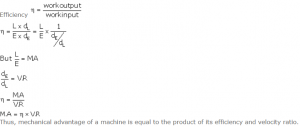
Question 14
How is the mechanical advantage related with the velocity ratio for an actual machine? State whether the efficiency of such a machine is equal to 1, less than 1 or more than 1.
Answer 14
The mechanical advantage for an actual machine is equal to the product of its efficiency and velocity ratio.

Question 15
State one reason why is mechanical advantage less than the velocity ratio for an actual machine.
Answer 15
This is because the output work is always less than the input work, so the efficiency is always less than 1 because of energy loss due to friction.
M.A. = V.R. * n
Question 16
What is a lever? State its principle.
Answer 16
A lever is a rigid, straight or bent bar which is capable of turning about a fixed axis.
Principle: A lever works on the principle of moments. For an ideal lever, it is assumed that the lever is weightless and friction less. In the equilibrium position of the lever, by the principle of moments,
Moment of load about the fulcrum=Moment of the effort about the fulcrum.
Question 17 (Machines ICSE Class-10 Concise )
Write down a relation expressing the mechanical advantage of a lever.
Answer 17

This is the expression of the mechanical advantage of a lever.
Question 18
Name the three classes of levers and state how are they distinguished. Give two examples of each class.
Answer 18
The three classes of levers are:
(i)Class I levers: In these types of levers, the fulcrum F is in between the effort E and the load L. Example: a seesaw, a pair of scissors, crowbar.
(ii)Class II levers: In these types of levers, the load L is in between the effort E and the fulcrum F. The effort arm is thus always longer than the load arm. Example: a nut cracker, a bottle opener.
(iii)Class III levers: In these types of levers, the effort E is in between the fulcrum F and the load L and the effort arm is always smaller than the load arm. Example: sugar tongs, forearm used for lifting a load.
Question 19
Give one example each of a class I lever where mechanical advantage is (a) more than 1, and (b) less than 1.
Answer 19
(a) More than one: shears used for cutting the thin metal sheets.
(b)Less than one: a pair of scissors whose blades are longer than its handles.
Question 20
What is the use of lever if its mechanical advantage is (a) more than 1, (b) equal to 1, and (c) less than 1?
Answer 20
When the mechanical advantage is less than 1, the levers are used to obtain gain in speed. This implies that the displacement of load is more as compared to the displacement of effort.
Question 21
Both a pair of scissors and a pair of pliers belong to the same class of levers. Name the class of lever. Which one has the mechanical advantage less than 1?
Answer 21
A pair of scissors and a pair of pliers both belong to class I lever.
A pair of scissors has mechanical advantage less than 1.
Question 22
Explain why scissors for cutting cloth may have blades longer than the handles, but shears for cutting metals have short blades and long handles.
Answer 22
A pair of scissors used to cut a piece of cloth has blades longer than the handles so that the blades move longer on the cloth than the movement at the handles.
While shears used for cutting metals have short blades and long handles because as it enables us to overcome large resistive force by a small effort.
Question 23
Figure 3.12 shows a uniform metre scale of weight W supported on a fulcrum at the 60 cm mark by applying the effort E at the 90 cm mark.
(a) State with reasons whether the weight W of the rule is greater than, less than or equal to the effort E.
(b) Find the mechanical advantage in an ideal case.

Answer 23
(a) The weight W of the scale is greater than E.
It is because arm on the side of effort E is 30 cm and on the side of weight of scale is 10 cm. So, to balance the scale, weight W of scale should be more than effort E.
(b)
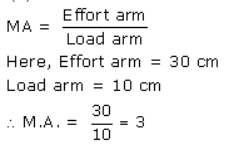
Question 24 (Machines ICSE Class-10 Concise )
Which type of lever has a mechanical advantage always more than 1? Give reason with one example. What change can be made in this lever to increase its mechanical advantage?
Answer 24
Class II lever always have a mechanical advantage more than one.
Example: a nut cracker.
To increase its mechanical advantage we can increase the length of effort arm.
Page 58
Question 25
Draw a diagram of a lever which is always used as a force multiplier. How is the effort arm related to the load arm in such a lever?
Answer 25
Diagram:

The effort arm is longer than load arm in such a lever.
Question 26
Explain why the mechanical advantage of a class II type of lever is always more than 1.
Answer 26
In these types of levers, the load L is in between the effort E and the fulcrum F. So, the effort arm is thus always longer than the load arm. Therefore M.A>1.
Question 27
Draw a labelled diagram of a Class II lever. Give one example of such a lever.
Answer 27
Diagram:

Example: a bottle opener.
Question 28
fig 3.13 shows a lemon crusher.
(a) In the diagram, mark the position of the directions of load L and effort E.
(b) Name the class of lever.
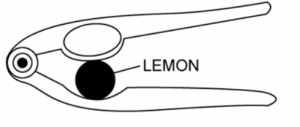
Answer 28
(a)

(b) It is class II lever.
Question 29
The diagram below shows a rod lifting a stone.
(a) Mark position of fulcrum F and draw arrows to show the directions of load L and effort E.
(b) What class of lever is the rod?
(c) Give one more example of the same class of lever stated in part (b).
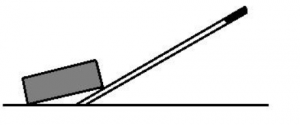
Answer 29
(a) 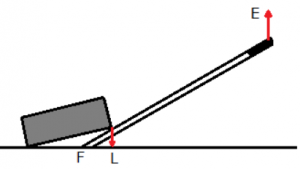
(b)This rod is a class II lever as load is between fulcrum and effort.
(c)An example of class II lever is a bottle opener.
Question 30 (Machines ICSE Class-10 Concise )
State the kind of lever which always has the mechanical advantage less than 1. Draw a labelled diagram of such lever.
Answer 30
Classes III levers always have mechanical advantage less than one.
Diagram:

Question 31
Explain why the mechanical advantage of the class III type of lever is always less than 1.
Answer 31
In these types of levers, the effort is in between the fulcrum F and the load L and so the effort arm is always smaller than the load arm. Therefore M.A. < 1.
Question 32
Classes III levers have mechanical advantage less than 1. Why are they then used?
Answer 32
With levers of class III, we do not get gain in force, but we get gain in speed, that is a longer displacement of load is obtained by a smaller displacement of effort.
Question 33
Draw a labelled sketch of a class III lever. Give one example of this kind of lever.
Answer 33
Diagram:

Examples: foot treadle.
Question 34
State the class of levers and the relative positions of load (L), effort (E) and fulcrum (F) in (a) a bottle opener, and (b) sugar tongs.
Answer 34
(a) A bottle opener is a lever of the second order, as the load is in the middle, fulcrum at one end and effort at the other.
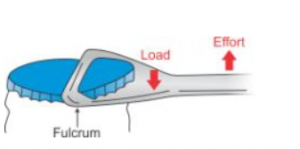
Bottle opener
(b) Sugar tongs is a lever of the third order as the effort is in the middle, load at one end and fulcrum at the other end.
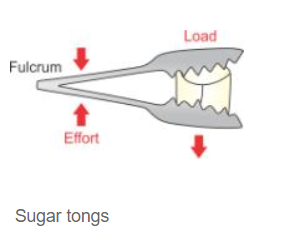
Question 35
Draw diagrams to illustrate the position of fulcrum, load and effort, in each of the following:
(a)A seesaw
(b)A common balance
(c)A nut cracker
(d)Forceps.
Answer 35
(a) A seesaw
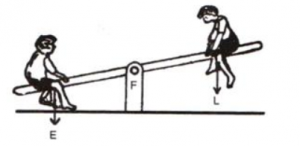
(b) A common balance
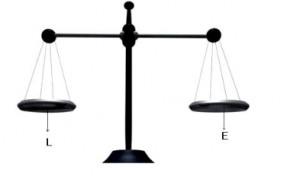
(c) A nut cracker
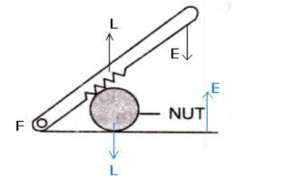
(d) Forceps.
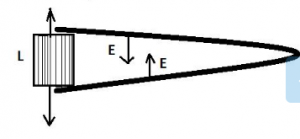
Question 36 (Machines ICSE Class-10 Concise )
Classify the following into levers as class I, class II or class III:
(a) A door
(b) a catapult
(c) Claw hammer
(d) a wheel barrow
(e) a fishing rod.
(f) Sugar tongs
Answer 36
(a) Class II
(b) Class I
(c) Class I
(d) Class II
(e) Class III
(f) Class III
Question 37
What type of lever is formed by the human body while (a) raising a load on the palm, and (b) raising the weight of body on toes?
Answer 37
(a) Class III.
Here, the fulcrum is the elbow of the human arm. Biceps exert the effort in the middle and load on the palm is at the other end.
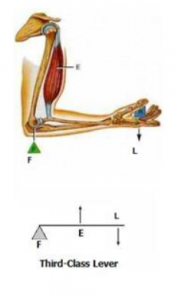
(b) Class II.

Here, the fulcrum is at toes at one end, the load (i.e. weight of the body) is in the middle and effort by muscles is at the other end.
Question 38
Indicate the positions of load L, effort E and fulcrum F in the forearm shown below. Name the class of lever.
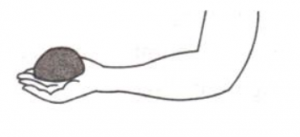
Answer 38
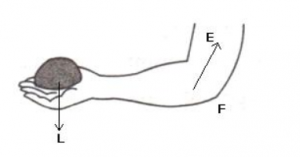
It is Class III lever.
Question 39 (Machines ICSE Class-10 Concise )
Give example of each class of lever in a human body.
Answer 39
- Class I lever in the action of nodding of the head: In this action, the spine acts as the fulcrum, load is at its front part, while effort is at its rear part.
- and Class II lever in raising the weight of the body on toes: The fulcrum is at toes at one end, the load is in the middle and effort by muscles is at the other end.
- while Class III lever in raising a load by forearm: The elbow joint acts as fulcrum at one end, biceps exerts the effort in the middle and a load on the palm is at the other end.
Question 40
Complete the following sentences:
(a) Mechanical advantage = ___________ × velocity ratio
(b) In class II lever, effort arm is __________ than the load arm.
(c) A scissors is a ___________ multiplier.
Answer 40
(a) Mechanical advantage = efficiency × velocity ratio
(b) In class II lever, effort arm is greater than the load arm.
(c) A scissors is a speed multiplier.
Exercise 3 (A) MCQ Machines (Selina Physics Solution)
Page 58
Question 1
Mechanical advantage (M.A.), load (L) and effort (E) are related as:
(a) M.A. = L x E
(b) M.A. x E = L
(c) E = M.A. x L
(d) None of these
Answer 1
(b) M.A. x E = L
Question 2
The correct relationship between the mechanical advantage (M.A.), velocity ratio (V.R.) and efficiency () is:
(a) M.A. = x V.R.
(b) V.R. = x M.A.
(c) n=M.A. x V.R.
(d) None of these
Answer 2
(a) M.A. = x V.R.
Question 3
State the incorrect statement:
(a) A machine always has the efficiency less than 100%.
(b) The mechanical advantage of a machine can be less than 1.
(c) A machine can be used as speed multiplier.
(d) A machine can have the mechanical advantage greater than the velocity ratio.
Answer 3
(d) A machine can have the mechanical advantage greater than the velocity ratio.
Question 4 (Machines ICSE Class-10 Concise )
The lever for which the mechanical advantage is less than 1 has the :
(a) Fulcrum at mid-point between load and effort.
(b) Load between effort and fulcrum.
(c) Effort between fulcrum and load.
(d) Load and effort acting at the same point.
Answer 4
(c) Effort is between fulcrum and load
Question 5
Class II levers are designed to have:
(a) M.A. = V.R.
(b) M.A. > V.R.
(c) M.A. > 1
(d) M.A. < 1
Answer 5
(c) M.A. > 1
NUMERICALS- 3 (A) Chapter – 3, Machine “Selina Physics Solution”
Page 59
Question 1
A crowbar of length 120 cm has its fulcrum situated at a distance of 20 cm from the load. Calculate the mechanical advantage of the crowbar.
Answer 1
Total length of crowbar =120 cm
Load arm =20 cm
Effort arm = 120-20 =100 cm
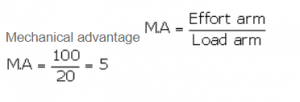
Question 2
A pair of scissors has its blades 15 cm long, while its handles are 7.5 cm long. What is its mechanical advantage?
Answer 2
Effort arm = 7.5 cm
Load arm = 15 cm
![]()
Question 3
A force of 5 kgf is required to cut a metal sheet. A shears used for cutting the metal sheet has its blades 5 cm long, while its handle is 10 cm long. What effort is needed to cut the sheet?
Answer 3
Effort arm = 10 cm
Load arm = 5 cm

Question 4
Fig.3.16 below shows a lever in use.

(a) To which class of lever does it belong?
(b) If AB =1 m, AF= 0.4 m, find its mechanical advantage.
(c) Calculate the value of E
Answer 4

Question 5
A man uses a crowbar of length 1.5 m to raise a load of 75kgf by putting a sharp edge below the bar at a distance 1 m from his hand. (a) Draw a diagram of the arrangement showing the fulcrum (F), load (L) and effort (E) with their directions. (b) State the kind of lever. (c) Calculate: (i) load arm, (ii) effort arm, (iii) mechanical advantage, and (iv) the effort needed.
Answer 5
Diagram:
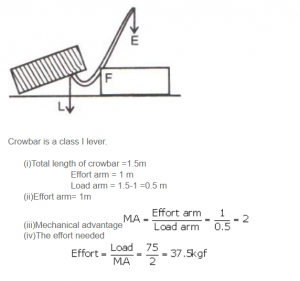
Question 6
A pair of scissors is used to cut a piece of a cloth by keeping it at a distance 8.0 cm from its rivet and applying an effort of 10 kgf by fingers at a distance 2.0 cm from the rivet.
(a) Find: (i) the mechanical advantage of scissors and (ii) the load offered by the cloth.
(b) How does the pair of scissors act: as a force multiplier or as a speed multiplier?
Answer 6
Effort arm = 2 cm
Load arm = 8.0 cm
Given effort =10 kgf

Question 7 (Machines ICSE Class-10 Concise )
A 4 m long rod of negligible weight is to be balanced about a point 125 cm from one end and A load of 18 kgf is suspended at a point 60 cm from the support on the shorter arm.
(a) If a weight W is placed at a distance of 250 cm from the support on the longer arm, Find W.
(b) If a weight 5 kgf is kept to balance the rod, find its position.
(c) To which class of lever does it belong?
Answer 7
Total length of rod = 4 m = 400 cm
(a)18 kgf load is placed at 60 cm from the support.
W kgf weight is placed at 250 cm from the support.
By the principle of moments
18 x 60 = W x 250
W = 4.32 kgf
(b)Given W=5 kgf
18 kgf load is placed at 60 cm from the support.
Let 5 kgf of weight is placed at d cm from the support.
By the principle of moments
18 x 60 = 5 x d
d = 216 cm from the support on the longer arm
(c) It belongs to class I lever.
Question 8
A lever of length 9 cm has its load arm 5 cm long and the effort arm is 9 cm long. (a) To which class does it belong? (b) Draw diagram of the lever showing the position of fulcrum F and directions of both the load L and effort E. (c) What is the mechanical advantage and velocity ratio if the efficiency is 100%? (d) What will be the mechanical advantage and velocity ratio if the efficiency becomes 50%?
Answer 8
(a) Length of the lever is same as the effort arm. Also, effort arm is more than load arm. So, this is a class II lever.
(b)
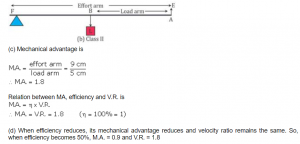
Question 9 (Machines ICSE Class-10 Concise )
Fig. 3.17 below shows a lever in use.
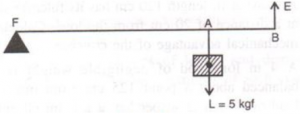
(a) To which class of lever does it belong?
(b) When the load is shifted towards the fulcrum, then less effort is required to lift the load and thus mechanical advantage of the lever increases.
Answer 9
(a) This is a class II lever.
(b) Given: FA=80 cm, AB = 20 cm, BF = FA + AB = 100 cm

Question 10
Fig. 3.18 shows a wheel barrow of mass 15 kg carrying a load of 30 kgf with its center of gravity at A. The points B and C are the centre of wheel and tip of the handle such that the horizontal distance AB = 20 cm and AC = 40 cm.
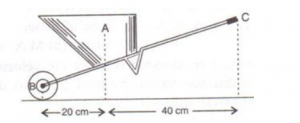
Find: (a) the load arm, (b) the effort arm, (c) the mechanical advantage, and (d) the
minimum effort required to keep the leg just off the ground.
Answer 10
(a)
(i) Load arm AF=20 cm
(ii)Effort arm CF=60 cm
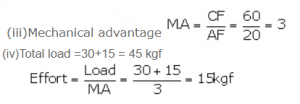
Question 11 (Machines ICSE Class-10 Concise )
Fig. 3.19 below shows the use of a lever.

(a) State the principle of moments as applied to the above lever.
(b) To which class of lever does it belong? Give an example of this class of lever.
(c) If FA = 10 cm, AB = 490 cm, calculate: (i) the mechanical advantage, and (ii) the minimum effort required to lift the load (= 50 N).
Answer 11
(a)The principle of moments: Moment of the load about the fulcrum=moment of the effort about the fulcrum
FB x Load = FA x Effort
(b)Class III;Sugar tongs the example of this class of lever.
(c)Given: FA=10 cm, AB = 500 cm, BF =490+10=500 cm.
The mechanical advantage
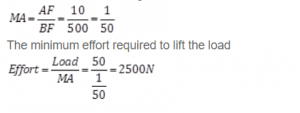
Question 12
A fire tongs has its arms 20 cm long. It is used to lift a coal of weight 1.5kgf by applying an effort at a distance 15 cm from the fulcrum. Find: (i) the mechanical advantage of fire tongs and (ii) the effort needed.
Answer 12
Fire tongs has its arms =20 cm
Effort arm = 15 cm
Load arm =20 cm

Return to Concise Selina ICSE Physics Class-10
Thanks

